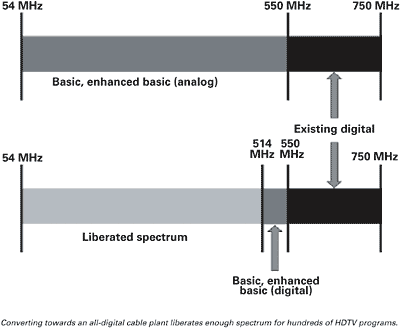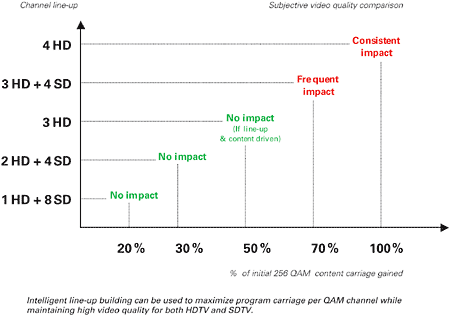Watching HDTV’s Horizons
In 2002, the cable industry publicly stated its commitment to introduce high-definition TV (HDTV) programming. Fulfillment since then has been impressive, including recent disclosure that the industry now makes the rich program format available in 99 out of the top 100 media markets. In this widespread introduction, cable effectively has countered early efforts by direct broadcast satellite (DBS) operators and over-the-air broadcasters to gain leads in their HDTV associations. There now are further opportunities to fully leverage inherent cable plant advantages and capitalize on providing subscribers with the most complete and compelling next-generation HDTV services. More program offerings Early HDTV roll-outs over cable typically have included five to 10 program offerings. However, when one considers all of the over-the-air, mainstream cable brand, premium, HDTV-specific and regional sports content available, more than 20 programs could be made available in most areas already. And that figure seems to be doubling every few years. The last decade’s implementation of hybrid fiber/coax (HFC) networks and Moving Picture Experts Group (MPEG-2) digital carriage was supposed to secure the cable industry’s absolute bandwidth advantage vs. alternatives and forestall any further investments in plant capacity for a long time. But HDTV’s success as well as the simultaneous growth of offerings such as video-on-demand (VOD) and tiered high-speed data have proven the axiom that given bandwidth, people tend to find a way to fill it. At more than five times the required capacity of standard definition TV (SDTV) programming, HDTV does indeed present a dilemma, with conventional encoding techniques requiring half of a 6 MHz channel per program. Thus, carriage of 20 HDTV programs equates to nearly 10 percent of all spectrum on most cable networks, an amount that is rarely available. Operators must identify means of alleviating bandwidth pressures to support HDTV rollouts. Fortunately several alternatives are available without repeating the multibillion dollar investments by the industry in the last decade’s upgrades and rebuilds. Digital transition One alternative is to transition all cable programming content (See Figure 1), including standard quality, to digital formats to leverage the associated bandwidth efficiency gains of more than 10 fold. The associated savings of such all-digital conversions are tremendous, given that more than half of all spectrums are allocated conventionally to analog programming on most cable networks. The earliest all-digital transitions currently are being implemented, based on a technique known as digital simulcast in which basic and enhanced basic programs temporarily are carried in both analog and digital formats. This allows the cable operator to transition gradually out of legacy analog subscriber devices and then liberate enough spectrum for hundreds of HDTV programs alongside other emerging types of services and content. Another technique for effective bandwidth expansion, that can be used on its own or with all-digital, is switched broadcast. In this practice, certain programs are included in a pool to be provisioned dynamically to service areas within the cable plant only when subscribers within those areas request them. Usually, there are hundreds of programs not being watched in a given area at a given time, and with switched broadcast, the spectrum associated with these programs becomes available, which also allows for a lot of HDTV carriage. Best picture quality Rate shaping is a technique gaining increasing interest as a means to maximize bandwidth efficiency of HDTV programming. This involves real-time analysis of program characteristics, including determination of bit rate reductions that can be performed with minimal impact on program quality. Given the emphasis on picture quality for HDTV in particular, there has been understandable conservatism on the application of rate shaping techniques to this program format. However, as algorithms have matured, indications are that intelligently applied rate shaping promises to boost HDTV bandwidth efficiency by 50 percent or more without deteriorating quality. Intelligent control over channel lineups is key to effective rate shaping of HDTV. Rate shaping is driven by program complexity, which describes the intensity of MPEG-2 processing required for a program stream given factors such as pixilation detail and motion dynamics. Lower complexity equates to applicability of rate shaping with the least impact on quality. Emerging smart lineup building tools (See Figure) analyze complexity and recommend the best program multiplexes, with combinations of complexity levels and program quality priorities, so that undesired quality impact is minimized. With these techniques, three HDTV programs could be multiplexed into a single 6-MHz channel, as long as they encompass a range of complexities, such as a sports program multiplexed with a premium movie program and a comedy/drama program. Multiplexing combinations of HDTV programs and SDTV programs within the same channels also has advantages. Content availability A significant amount of available HDTV programming comes from over-the-air sources, and certain elements are nontrivial for cable plant carriage. These include techniques for including data on issues such as closed captioning, program guide information and parental control, as well as coping with shifts in spectrum usage between HDTV and SDTV by broadcasters. Program and system information protocol (PSIP) was developed for over-the-air broadcast-relevant data, ranging from broadcaster branding to V-chip controls. These data are not inherently available for carriage over cable, which could introduce regulatory dilemmas. The industry is committing to providing subs with complete HDTV experiences, and emerging program multiplexing tools include capabilities to extract and regenerate PSIP data over the cable plant for comprehension by any subscribing device, including emerging cable-ready digital TV (DTV) monitors. Another over-the-air broadcaster practice that can vex cable operators is shifting use of allocated digital spectrum throughout the day between HDTV programming and combinations of SDTV programming. This is another issue that more intelligent cable multiplexing platforms can address, such as identifying those moments when HDTV programming is not available where a subscriber would expect it and inserting a notification of the situation and subscribers’ alternatives, rather than generating a blank screen when the particular program is requested. Broadcasters also are inconsistent at times in how HDTV and other digital programs are made available. Programs can be provided in either 4:3 or 16:9 aspect ratios. Subscribers who invest in high-end DTV monitors often expect to stretch the narrower profile programs to fill their wide screens. But programming upconverted to HDTV in 4:3 aspect ratio does not provide this alternative, which is another situation to which a smarter cable plant can alert subscribers. Service enhancement DTV monitor purchases have well exceeded forecasts, now approaching several million units per quarter. The subscribers adopting HDTV are some of the cable industry’s most enthusiastic customers, and the industry is embarking upon expanding service offerings to this base to best capitalize on opportunities. HDTV consumers are a self-defined demographic, willing to part with disposable income that is highly attractive to advertisers. The cable industry currently derives billions of dollars in annual revenues from local advertising sales and has worked to establish the standards for extending this practice to digital programming. Doing so for HDTV opens another exciting business opportunity. VOD meets HDTV There also is increasing interest in the possibility of using HDTV standards for VOD programming. Subscribers increasingly are accustomed to complete control over their viewing experiences, in addition to expecting ever-increasing quality levels. Given alternatives such as digital versatile disc (DVD) and digital video recorders (DVRs), high-definition VOD (HDVOD) is an important competitive offering. This practice combines HDTV’s high bit rate streams with VOD’s high stream counts, which elevates the need for better data throughput and bandwidth management. But HDVOD is an example of the cable industry’s unique ability to leverage its high bandwidth, addressable plant to provide subscribers with the richest service offerings and emerge as the distinctive leader in provision of next generation HDTV services. Seth Kenvin is vice president, corporate development for BigBand Networks. Email him at sethk@bigbandnet.com. Sylvain Riviere is director product marketing for BigBand Networks. Email him at sylvainr@bigbandnet.com. FIGURE 1: All-Digital Bandwidth Consumption  FIGURE 2: Intelligent Program Line-ups
FIGURE 2: Intelligent Program Line-ups 